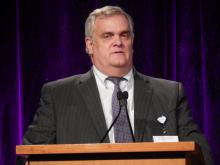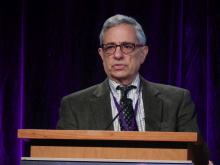BOSTON – Ablation of atrial fibrillation led to significantly better quality of life improvements, compared with antiarrhythmic drug therapy, in a prespecified, secondary analysis of data from the CABANA multicenter, randomized trial with 2,204 patients.
The improvements in quality of life measures in atrial fibrillation (AF) patients following ablation were “clinically meaningful” relative to drug therapy and were sustained for 5 years of follow-up, said Douglas L. Packer, MD, at the annual International AF Symposium.
The apparent incremental benefit in quality of life after ablation, compared with patients treated with drug therapy, added to the benefits previously reported from CABANA (Catheter Ablation vs. Antiarrhythmic Drug Therapy for Atrial Fibrillation Trial) using ablation that included a highly significant reduction in recurrent AF and a significant reduction in the combined endpoint of mortality or cardiovascular hospitalization. However, the trial’s results were neutral for the study’s prespecified primary endpoint, a combination of the rate of total mortality, disabling stroke, serious bleeding, or cardiac arrest in an intention-to-treat analysis, a result first reported by Dr. Packer at the annual scientific sessions of the Heart Rhythm Society in May 2018.
When Dr. Packer spoke at the AF Symposium in late January 2019, the CABANA results had still not been published. He said that he expected an article with the main findings to appear online sometime in February 2019.
The quality of life analysis, focused on two measures, the Mayo AF-Specific Symptoms Inventory (MAFSI) (Circulation. 2008 Oct 28;118[suppl 18]:S589) and the Atrial Fibrillation Affect on Quality of Life (AFEQT) (Circ Arrhythm Electrophysiol. 2011 Feb;4[1]:15-25). The patients enrolled in the two treatment arms of CABANA had essentially identical baseline MAFSI frequency scores, but starting 3 months after entry patients randomized to the ablation arm had an average, statistically significant 1.6-point improvement in their adjusted MAFSI frequency score, compared with patients in the drug-therapy arm; this reduction persisted at about the same statistically significant level through 5 years, said Dr. Packer, an electrophysiologist and professor of medicine at the Mayo Clinic in Rochester, Minn., and lead investigator of CABANA. Patients who remained in follow-up throughout the study’s entire 60 months underwent a total of seven MAFSI assessments after their initial treatment; the average, adjusted difference in MAFSI frequency scores throughout CABANA was a statistically significant 1.4 points lower among ablated patients, compared with those randomized to drug therapy, said Dr. Packer, who presented data first reported by the CABANA researchers in 2018.
The pattern of change in the AFEQT scores was very similar. The average, adjusted AFEQT summary scores were virtually identical at baseline for the two treatment arms, but at 3 months after the study began patients in the ablation arm had an average, adjusted, statistically significant 3-point improvement in their AFEQT summary scores, compared with drug-treated patients; this incremental increase in AFEQT scores remained consistent and statistically significant through 5 years of follow-up. Throughout the study, the average, adjusted, incremental improvement in AFEQT after ablation was a statistically significant 3.4 points, said Dr. Packer.
But these quality of life measures in patients who received unblinded assignment to an ablation procedure or drug treatment in CABANA are likely unreliable, commented Peter R. Kowey, MD, an electrophysiologist at the Lankenau Heart Institute in Wynnewood, Penn., and professor of medicine at Jefferson Medical College, Philadelphia.
“Assessing quality of life in an unblinded trial seems to me to be pretty shallow,” said Dr. Kowey, a member of the CABANA steering committee and a participant in a panel at the Symposium that discussed the results. Patients who have just gone through a 6-hour procedure will often say they now feel a whole lot better, he suggested. “They’re concerned what will get done to them if they don’t say they feel better.” The same confounding also applies to other “soft” secondary endpoints used in CABANA, such as hospitalization rates.
The reliability of these more subjective outcome measures is reduced in an unblinded trial, Dr. Kowey maintained. The CABANA results “don’t change the fundamental principal of using hard endpoints,” such as those that made up the primary endpoint of the study, he said in an interview. “We put secondary endpoints into the study because they are legitimate things to look at, but they have questionable reliability,” as measures of ablation’s efficacy.
Dr. Kowey also cautioned against focusing on the per-protocol and treatment-received analyses of the CABANA results, prespecified analyses that Dr. Packer highlighted because of the high number of crossovers in the trial: 9% of patients assigned to ablation never received it and 28% of patients assigned to drug therapy actually received ablation.
The CABANA steering committee anticipated a high crossover rate, but still set the intention-to-treat analysis as primary because “per protocol introduces many biases and can’t be relied on for a study of this magnitude,” Dr. Kowey said. He also cited the statistical pitfalls of looking at multiple secondary endpoints in the CABANA results and the danger of reading too much into subgroup analyses, all from a trial with a neutral primary endpoint.
Another concern he raised centered on the generalizability of CABANA’s safety findings, which showed roughly similar adverse event rates between the two treatment arms – about 9% with ablation, 4% with drugs – although the distribution of complications types differed between the two arms. The “ ‘remarkably safe’ performance of ablation in CABANA can be attributed to ‘cherry-picked’ investigators” who performed the ablation procedures at high-volume centers, said Dr. Kowey. “The safety of ablation was predictable” in CABANA because of the selection of participating centers. “Seventy percent of U.S. ablations are being done at centers that do fewer than 25 ablations annually,” Dr. Kowey said. “We don’t know what goes on” at lower-volume centers; “ablation can’t be considered as safe as we presume” when done at centers outside the 118 sites that participated in CABANA, he maintained.
CABANA received partial funding from Biosense Webster, Boston Scientific, Medtronic, and St. Jude. Dr. Packer has been a consultant to these four companies as well as to CyberHeart, nContact, Sanofi-Aventis, and Toray. He has received research funding from AG, Biosense Webster, Boston Scientific, CryoCath, EP Limited, and Medtronic, and has a financial interest in AF mapping technology. Dr. Kowey has been a consultant to several companies that market antiarrhythmic drugs or market arrhythmia devices and has an equity interest in BioTelemetry.



